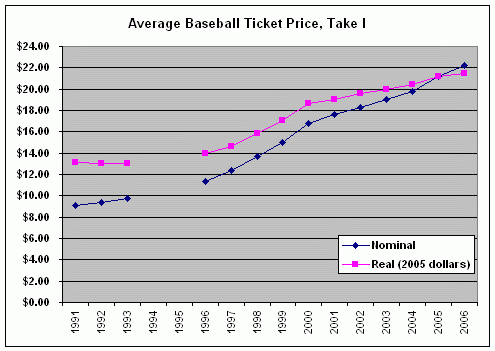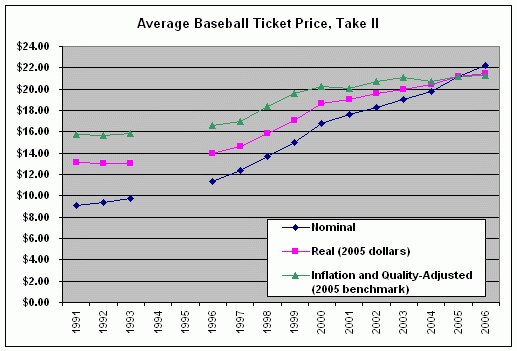BP Comment Quick Links

 | |
September 6, 2007 Lies, Damned LiesTicket Pricing
A friend and I went to a Cubs game last week and were bantering about the impending sale of the club and just what we'd do to increase revenues from ballpark operations at Wrigley Field. I said I'd make tickets more expensive. He said he'd cheapen the fan experience. Well, that's not exactly what he said, but he said he'd tear out the ivy, put advertisements all over the outfield wall, fill in the center field batter's eye, and replace the organist with an iPod. I told him he should stay in finance. Nevertheless, this gets to an interesting point: When you put your money down for an afternoon at the ballpark, what exactly are you paying for? You aren't paying Alfonso Soriano's salary, at least not in any economically meaningful sense, but if a team believes that it's putting a better product on the field, that's going to be priced into the ticket. Similarly, you aren't paying directly for the atmosphere and the amenities, but if the ballpark has a beautiful view or some awe-inspiring history, that's going to be accounted for in the ticket price as well. You often hear these days about the rising cost of baseball tickets… actually, you don't hear much about that right now. Here are the number of hits in the New York Times' archive for "baseball" in conjunction with "ticket price" or "ticket prices" for each year since 1990:
2007 4 2006 11 2005 7 2004 23 2003 18 2002 41 2001 29 2000 24 1999 22 1998 42 1997 22 1996 31 1995 43 1994 34 1993 15 1992 20 1991 12 1990 14 There is a pretty high correlation between these numbers and the degree of labor strife within baseball. You don't hear much about ticket prices when they're actually increasing (the highest nominal rises in ticket prices in this period came in 2000), nor when the overall economy is slumping (as in 1990, 1991, and 2001), nor when salaries are going through the roof (as in 2007). Rather, you hear about them when someone has a public relations war to win, and they manage to frame the discussion accordingly. For the time being, the "overpaid athletes ruining the ballpark experience for me and my family" meme seems to have died down. Setting that aside, let's look at some hard data. The following are real (inflation-adjusted) and nominal ticket prices since 1991 according to data compiled by Team Marketing Report. (Also, note that I'm not calculating for 1994 and 1995, setting those two seasons aside as years in which a major external event--in this case, the incipient labor war and the year that followed it--loomed over the industry.)
 On a nominal basis, ticket prices have grown at a compound annual rate of 6.5 percent since 1991. Inflation alone accounts for about half of this; the real rate of increase over that period is 3.3 percent. Baseball salaries, by contrast, have grown at an inflation-adjusted compound rate of 5.5 percent over the same period. A growth rate of 3.3 percent is perhaps or perhaps not a cause for concern-it isn't college tuition-but in fact, this number overstates the effect. Think about where you might catch a baseball game in 1991. Astroturf was still fashionable, and Camden Yards was still just a gleam in Eli Jacobs' eye. The average stadium had a capacity of about 52,500 seats; today only four of the 30 ballparks will sell that many tickets per game. So you were paying less, but you were also paying for less, certainly in terms of the median experience at the ballpark itself, but arguably also in terms of the quality of play. Dan Fox figures that the quality of play was about five percent inferior in 1991 to what it is today. Baseball was still just getting started tapping its Latin American pipelines back then, and there were no players at all from Asia. Think on that-how many tickets have Ichiro Suzuki and Daisuke Matzusaka sold this year? Can we adjust for this kind of thing? Leaving aside the issue of the quality of play, we can, with a little data mining and just a modicum of creativity. I went back and updated the attendance database that I had designed for the Alex Rodriguez chapter in Baseball Between the Numbers, this time focusing on the inputs on ticket prices. I then performed a simple regression on inflation-adjusted ticket prices that accounts for the following:
I won't describe all the coefficients and the like here; instead, you can download the spreadsheet and fiddle with the estimates yourself. All of the numbers behave fairly intuitively-for example, ticket prices are $7 or $8 more in New York than in Kansas City, all else being equal, and seeing a game at PNC Park will cost you about $2 more than one at the Tropicana Dome for aesthetic reasons alone. The two variables that have tended to change over time are those for ballpark quality and capacity. The average ballpark today has a quality rating of 78, as compared to 67 in 1991, and the average seating capacity has shrunk by about 7,000 seats. The latter variable is particularly important, because having a bunch of crappy seats that you don't expect to fill will bog down the average ticket price. The average price of an A's ticket went up from $17.66 in 2005 to $22.10 in 2006, for example, simply because they stopped putting the Mount Davis seats in center field up for sale. We can use the regression a bit more specifically to estimate an expected ticket price that accounts for the improving quality of the ballpark experience. In 1991, the estimate of this price is $15.93 in inflation-adjusted terms, and in 2006, it is $19.25:
Ticket Prices Adjusted for Stadium Quality and Capacity Year Expected Average Ticket Price (2005 dollars) 1991 $15.93 1992 $15.90 1993 $15.70 1994 --- 1995 --- 1996 $16.12 1997 $16.49 1998 $16.44 1999 $16.68 2000 $17.62 2001 $18.14 2002 $18.03 2003 $18.07 2004 $18.80 2005 $19.11 2006 $19.25 That is, about $3.50 of the increase in ticket prices since 1991 has resulted solely from improved stadium design and smaller ballparks. This does not account for all of the increase in ticket prices, but it takes a substantial bite out if it. The final step is to return to the actual ticket prices, and adjust them not just for inflation but also for these tangible improvements in quality:
 The average ticket price today is $21 or $22, as compared with $9 in 1991. If we adjust for inflation, however, that 1991 price shoots up to $13, and if we adjust for both inflation and quality, it goes up to almost $16. A true apples-to-apples comparison, then, reveals that average ticket prices have been increasing at a CAGR of just 2.0 percent per year over the past decade and a half. That is right in line with the increase in real per-capita disposable income over the same period. What it boils down to is this-baseball tickets are every bit as affordable as they were 15 years ago, provided you're willing to acknowledge that you're buying a slightly better product.
Nate Silver is an author of Baseball Prospectus.
|